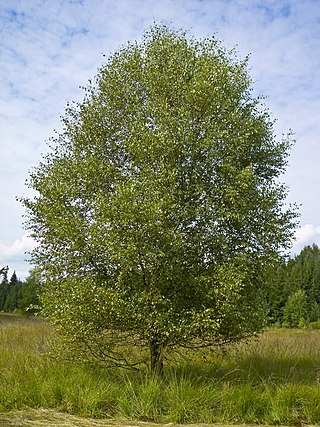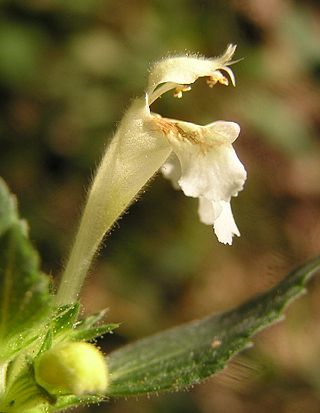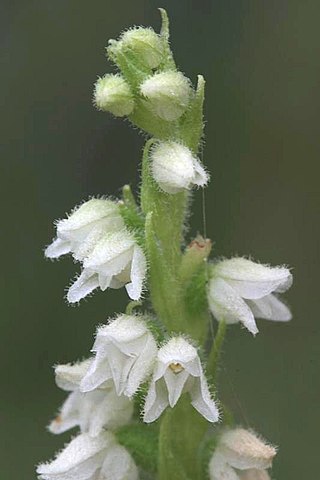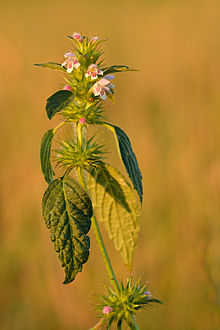
A birch is a thin-leaved deciduous hardwood tree of the genus Betula, in the family Betulaceae, which also includes alders, hazels, and hornbeams. It is closely related to the beech-oak family Fagaceae. The genus Betula contains 30 to 60 known taxa of which 11 are on the IUCN 2011 Red List of Threatened Species. They are a typically rather short-lived pioneer species widespread in the Northern Hemisphere, particularly in northern areas of temperate climates and in boreal climates.

Urtica dioica, often known as common nettle, burn nettle, stinging nettle or nettle leaf, or just a nettle or stinger, is a herbaceous perennial flowering plant in the family Urticaceae. Originally native to Europe, much of temperate Asia and western North Africa, it is now found worldwide. The species is divided into six subspecies, five of which have many hollow stinging hairs called trichomes on the leaves and stems, which act like hypodermic needles, injecting histamine and other chemicals that produce a stinging sensation upon contact.

Urtica is a genus of flowering plants in the family Urticaceae. Many species have stinging hairs and may be called nettles or stinging nettles, although the latter name applies particularly to Urtica dioica.

Celtis is a genus of about 60–70 species of deciduous trees, commonly known as hackberries or nettle trees, widespread in warm temperate regions of the Northern Hemisphere. The genus is part of the extended Cannabis family (Cannabaceae).

Betula pendula, commonly known as silver birch, warty birch, European white birch, or East Asian white birch, is a species of tree in the family Betulaceae, native to Europe and parts of Asia, though in southern Europe, it is only found at higher altitudes. Its range extends into Siberia, China, and southwest Asia in the mountains of northern Turkey, the Caucasus, and northern Iran. It has been introduced into North America, where it is known as the European white birch or weeping birch and is considered invasive in some states in the United States and parts of Canada. The tree can also be found in more temperate regions of Australia.

Betula pubescens, commonly known as downy birch and also as moor birch, white birch, European white birch or hairy birch, is a species of deciduous tree, native and abundant throughout northern Europe and northern Asia, growing farther north than any other broadleaf tree. It is closely related to, and often confused with, the silver birch, but grows in wetter places with heavier soils and poorer drainage; smaller trees can also be confused with the dwarf birch.

Lamium (dead-nettles) is a genus of about 30 species of flowering plants in the family Lamiaceae, of which it is the type genus. They are all herbaceous plants native to Europe, Asia, and northern Africa, but several have become very successful weeds of crop fields and are now widely naturalised across much of the temperate world.

Orchis is a genus in the orchid family (Orchidaceae), occurring mainly in Europe and Northwest Africa, and ranging as far as Tibet, Mongolia, and Xinjiang. The name is from the Ancient Greek ὄρχις orchis, meaning "testicle", from the appearance of the paired subterranean tuberoids.

Galeopsis segetum, commonly known as downy hemp-nettle, is a species of flowering plant in the sage family, Lamiaceae. It grows as a weed in arable ground throughout Europe. Although superficially resembling the stinging nettle it is of a different family and does not sting.

Galeopsis tetrahit, the common hemp-nettle or brittlestem hempnettle, is a flowering plant in the family Lamiaceae, native to Europe and northwestern Asia.

Rhamphospermum arvense, the charlock mustard, field mustard, wild mustard, or just charlock, is an annual or winter annual plant in the family Brassicaceae. It is found in the fields of North Africa, Asia, and Europe. Pieris rapae, the small white butterfly, and Pieris napi, the green veined white butterfly, are significant consumers of charlock during their larval stages.

Goodyera, commonly called rattlesnake plantain, jade orchids or ladies' tresses is a wide-ranging genus of orchids in the tribe Cranichideae. About 100 species of Goodyera have been formally described. With a center of diversity in East Asia, Goodyera is found across Europe, Madeira, North and Central America, Australia, and on islands from the west Indian Ocean to the Pacific Ocean. They have a rosette of leaves at their base and usually many small white resupinate flowers. They are similar to orchids in the genus Spiranthes but can be distinguished from them by the shape and colour patterns of the leaves.

Galeopsis speciosa, the large-flowered hemp-nettle or Edmonton hempnettle, is a species of annual herbaceous plants in the family Lamiaceae. It is native to northern and central Europe and Siberia. It has become a widespread introduced weed in Canada. The plant is poisonous and causes paralysis.

Galeopsis bifida is an annual plant native to Europe and Asia but now found in Canada and the northeastern, midwestern parts of the United States. It has many common names such as bifid hemp-nettle, split-lip hemp-nettle, common hemp-nettle, and large-flowered hemp-nettle. The genus name means weasel-like, referring to the corolla of the flower. It is often confused with other species of Lamiaceae such as Mentha arvensis, Dracocephalum parviflorum and Stachys pilosa.

Cassida viridis, common name green tortoise beetle, is a species of beetle in the leaf beetle family (Chrysomelidae).

Avenula is a genus of Eurasian flowering plants in the grass family. Over 100 names have been proposed for species, subspecies, varieties, and other infraspecific taxa within Avenula, but only one species is accepted. The others names are all regarded as synonyms of other accepted names. The only recognized species in the genus is Avenula pubescens, commonly known as downy oat-grass or downy alpine oatgrass, native to Europe and Asia from Iceland and Portugal to Xinjiang, Mongolia, and Siberia. It is also naturalized in scattered locations in North America, in states as Connecticut, Delaware, Minnesota, New Jersey and Vermont, and in Canadian provinces such as Alberta, Manitoba, Ontario, Quebec, and Saskatchewan.

Liriomyza eupatorii is a species of fly in the family Agromyzidae. The fly, is found in Europe and was described by the German entomolgist, Johann Heinrich Kaltenbach in 1874.

Galeopsis pubescens, also known as the hairy and downy hempnettle, is a herbaceous annual plant species in the family Lamiaceae, that can be found growing in various European countries.

Urtica cannabina, the hemp nettle, is a species of flowering plant in the family Urticaceae. It is native to Central Asia, Siberia, Mongolia, and northern and central China, and has been introduced to Ukraine, European Russia, and the Russian Far East. A perennial herb typically 50 to 150 cm tall, it is found in a wide variety of habitats, including anthropogenically disturbed ones. Attempts are being made in China to cultivate it for its fiber.



















